| 0 | 1 | ||
| 2 | 3 | ||
| 4 | 5 | ||
| 6 | 7 | ||
| 8 | 9 |
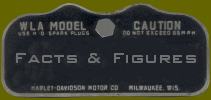

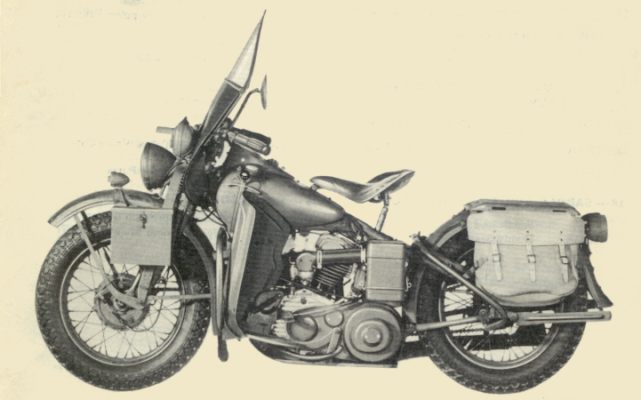
Motorcycle, Chain
Drive, Solo (Harley Davidson Model 42WLA)
Ordnance Supply Catalog G523 dated 15 September 1944
Harley-Davidson produced about
70.000 WLA and WLC military
motorcycles for the US Army and their Allies during WW2. Spare parts for an
additional
30.000 bikes were also produced.
WLAs were used extensively by US Troops for messenger and Military Police
duties and thousands were supplied to other
countries thru Lend Lease Agreements.
These bikes were nicknamed 'Liberators'
in Europe since they were ridden by troops liberating their towns and countries
from German occupation. The name has stuck ever since....
One of Belgium's most remembered 'Liberators' is commemorated every year in the Belgian town of Peruwelz where James Carroll of the 628th Tank Destroyer was the first GI to enter the village on 3rd September 1944 after 4 long years of German occupation.
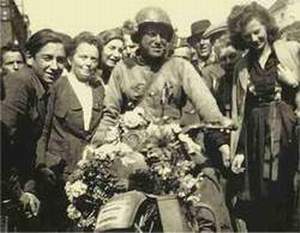
Photo from an unknown source
James Carroll's WLA
surrounded by overjoyed locals in Peruwelz, Belgium, on September 3rd, 1944.
This Liberator Story was published in the November 1998 edition of the 'American
Motorcyclist' magazine.
Read the complete story: Click
Here!
42WLA Origin & Production
During the first half of the 20th century, the Motorcycle was a common means of transport for both civil and government use. The US Army had fielded motorcycles since the Great War and had continued to use them as the ideal transport for messenger, reconnaissance and traffic control purposes...
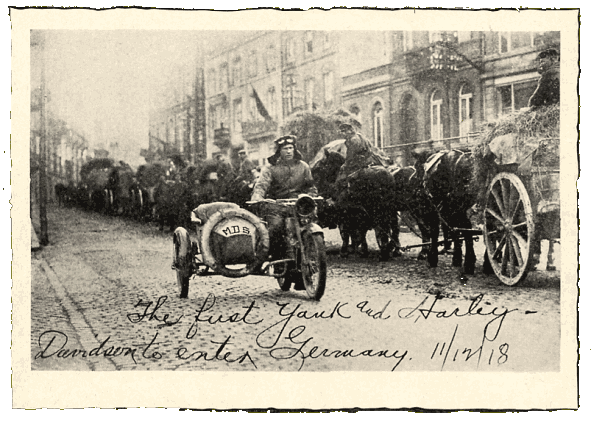
Photo: Harley-Davidson
Cpl Holtz on his
Harley-Davidson: the First Yank to Enter Germany at the End of the Great War
Read the complete story:
Click
Here!
In 1937,
Harley-Davidson introduced the W-series models fitted with a 45 cubic inch
engine whose most notable feature was
the recirculating oil system, which greatly reduced maintenance. Earlier motorcycles had been equipped with a total-loss oil system which made the
rider responsable for checking the oil, adjusting the oil pump or even using the
hand oil pump to properly lubricate the engine while riding. The US Army ordered
the 1937 WL Model to replace the Model RL Motorcycle then in use...
In 1939 the US Army purchased the 39W model. And in August 1939 two prototype
39WL(A)
Models were shipped to the Mechanized Cavalry Board at Fort Knox, Kentucky.
These were the first true 'WLA' Models having the typical military look.
The engine may have been numbered 39WLAxxxx, but this is not sure.
The 39WL(A) was a straight adaption of the civilian Model, still retaining the
I-beam type front forks.
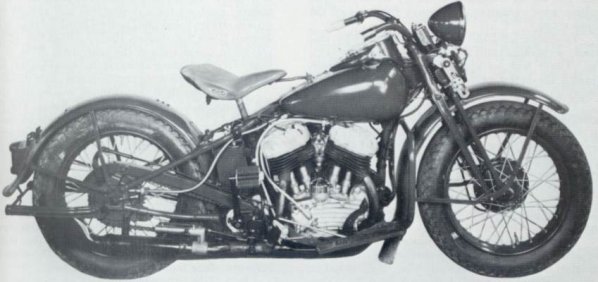
The 39WL(A) as it is shown in US Army Technical Manual
TM10-1510 The Motor Vehicle, Page 52.
When war broke out in Europe in September 1939, Fort Knox began an extensive
testing program on motorcycles from different manufacturers, amongst which the
two protoype 'WLA' Models, competing with Indian and Delco. The Harleys came
thru these tests with flying colors.
Between January and
March 1940, the US Army ordered more than 400 40WLA Models. The 40WLA Model was
the first type of which it is certain that it was delivered with the term 'WLA'
in the Engine Number. This makes it the 'Father' of the 41WLA and the
'Grandfather' of the Model 42WLA. These 40WLA and 41WLA served alongside UA, ELA, Indians,
etc......

Photo: Harley-Davidson
The 40WLA as
it was delivered to the US Army in 1940: the beginning of an American Icon...
By the time the Japanese attacked Pearl Harbor on December 7th, 1941, 41WLAs were a common sight in the Armed Forces. With the outbreak of war, Harley Davidson rapidly geared up for war production as the US Army required a rugged mass-produced model.
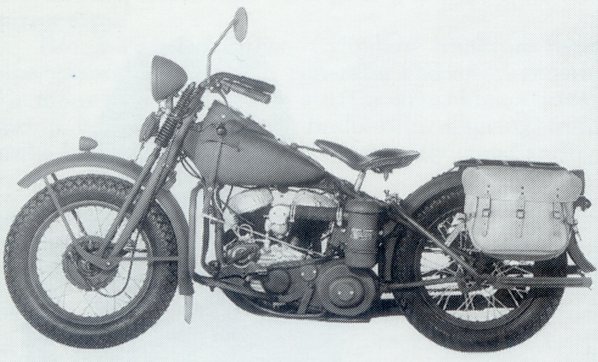
Photo: Harley-Davidson
The 41WLA
which would equip US Army Armored Units from the summer of 1940 onwards...
The 41WLA would soon evolve into the 42WLA of which thousands were manufactured between September 1941 and August 1945.
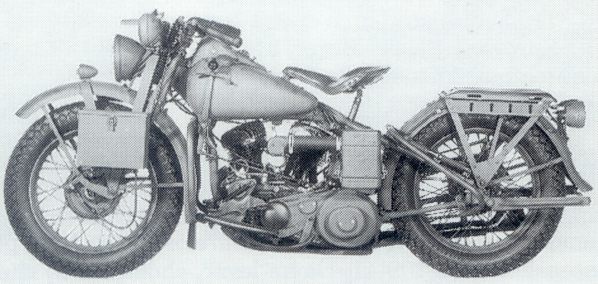
Photo: Harley-Davidson
The 42WLA as it
would go into combat around the globe...
Meanwhile the Army was impressed by the German BMW motorcycles and at the end of 1941, Harley Davidson built their 45-ci opposed twin, shaft driven 42XA model. Only 1.000 of these were manufactured and very few, if any, saw overseas use....
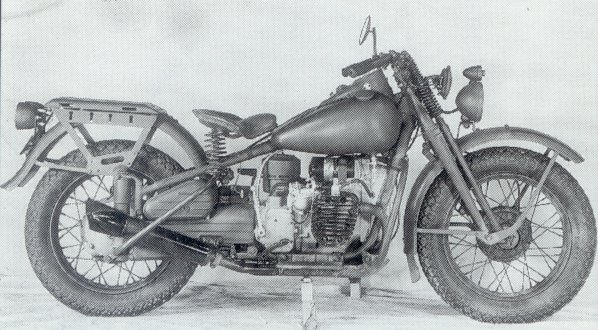
Photo:
Harley-Davidson
The 42XA with opposed
cylinder engine
The WLA
motorcycle was soon recognised as a sturdy and reliable vehicle and for their
Excellence in Production, the Harley-Davidson Motorcycle Company received the
Army-Navy "E" Award on May 12th, 1943. Only industries that participated in wartime
production were eligible to receive this award. The award ceremony was
elaborate, with high-level officers present and airforce fly-overs. William H
Davidson received the banner from Colonel Otjen, who called the Harley Davidson
workers: "Soldiers of the Production Line". Employees of the
company that received the award were entitled to wear an 'E' Pin on the lapel of
their jackets.
The award would be mentioned in all future advertising as a sign of support to
the War Effort.....
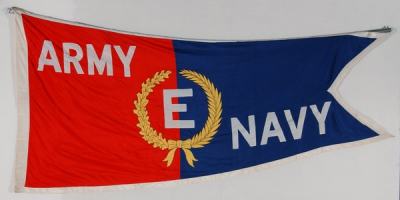
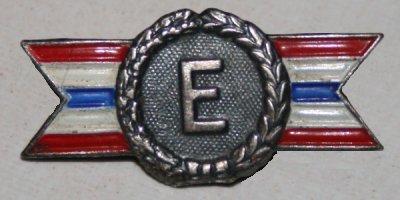
Photo: www.ohiomemory.org
(left) and pin from the Webmaster's Collection (right)
This Army/Navy
"E" Award pennant would have been given to a business that supported
the war effort during World War II.
The pennant (left) is approximately 18" x 8" 1/2, while the
employee-pin (right) is about 7/8" x 3/8"
The employee pin was
issued pinned on a card which mentioned the name of the worker and the company
he or she worked for.
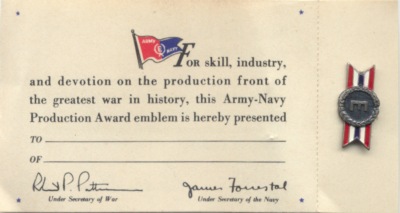
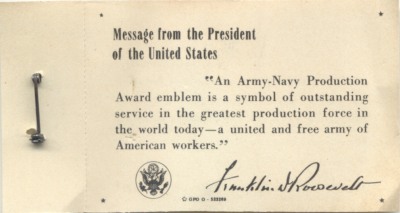
Front and rear views of an 'E' Pin Award Card from the Webmaster's Collection
The 42WLA would be manufactured over a period of 4 years; yet every bike would
receive an engine number starting with 42WLA, even bikes delivered in 1943, 1944
or 1945. This was unique in HD's history. The reason is not very clear, but it
sure made Army paperwork easier.
Although production details, parts or finishes
varied, the overall appearance of the 'Liberator' remained the same throughout
production. All 42WLAs were delivered in flat olive drab color.
After extensive vintage HD research, Bruce Palmer devised a unique
42WLA identification system by cataloging total production into 7 different
types. This system has been adopted by most WLA fans and these different types
are known as 42WLA Type I
thru Type VII.
Most common type was the Type III of which roughly 20.000 bikes
rolled off the Milwaukee production line.
Below is a chart showing which engine numbers were used in which types and what timeframe they were produced. The chart also shows the US Army Registration Numbers which were assigned to each bike.
The chart was compiled from information in Bruce Palmer's books. I would heartily recommend that every WLA owner gets those books as it will answer most, if not all questions on WW2 military HD's......
| 42WLA | Date of Manufacture | Engine Numbers (VIN) | USA Registration Numbers |
| Type I | September 1st 1941-December 10th 1941 | 42WLA1000-42WLA7000 | U.S.A.-W-69888-U.S.A.-W-611203 |
| Type II | December 10th 1941-February 15th 1942 | 42WLA7001-42WLA13650 | U.S.A.-W-611204-U.S.A.-W-614257 |
| Type III | May 8th 1942-April 1943 | 42WLA16001-42WLA39229 | U.S.A.-W-616923-U.S.A.-637235 |
| Type IV | April 1943-August 1943 | 42WLA39230-42WLA50829 | U.S.A.-671621-U.S.A.-683220 |
| Type V | September 1943-May 1944 | 42WLA50830-42WLA60000 | U.S.A.-686726-U.S.A.-695901 |
| Type VI | June 1944-August 1944 | 42WLA60001-42WLA62480 | U.S.A.-6110920-U.S.A.-6113399 |
| Type VII | September 1944-August 16th 1945 | 42WLA62481-42WLA70681 | U.S.A.-6128521-U.S.A.-6133520 U.S.A.-6138558-U.S.A.-6141758 |
Factory class restorations start from
here. If you come across 42WLA10506; it's a Type II and you should not mount a
late pattern lipless front fender during restoration if you're going for that
'Factory-Fresh-Straight-From-The-Assembly-Line' look!
Engine numbers and US Army
Registration numbers were assigned in blocks and therefore not every number in
the chart was actually issued. Starting with your engine number, it's not that
hard to find a proper USA number and Date of Manufacture......
There are also HD 45ci engines with WLH and WLJ numbers instead of the usual WLA marking. These were fitted to bikes issued to the Dutch (H for Holland) and Japanese government after WW2 and fall out of the scope of this site. The three-wheeled Servicar had a G numbered engine and the Canadian Army WLC had an engine number starting with either 42WLC or 43WLC. For more info on the WLC models, click Here!
What does WLA stand for?......
Throughout its history, Harley-Davidson has been using a combination of letters to designate the different models it manufactures. The Model WLA is no exception.
The 'W'
shows that the motorcycle is equipped with a 45 cubic inch, side valve engine, introduced in 1937
and first used on the Model W bikes.
The letter 'L'
stands for High Compression. It is however not indicative of compression on
current models.
And finally 'A'
indicates a model developed for Army use.
One could argue that the
'A'
indicates 'American' because the
'C' in
WLC stands for
'Canadian', but when
the term WLA was introduced, no-one could predict that Harley-Davidson would
be making motorcycles for the Canadian Government a couple of years later....
On a side note the XA
meant a motorcycle equipped with an opposed twin cylinder engine for Army use,
The UA
was a Big Twin equipped with a 74ci engine....
42WLA Engine Numbers......
WLAs
did not receive a frame tag or
frame number and were identified by the engine number, embossed on the left side
of the crankcase in the following fashion '42WLAXXXXX'. This was the Vehicle
Identification Number (VIN).
Furthermore all Harley-Davidson engine crankcases
were numbered during their production on the lower front side of both halves by
the year of manufacture followed by the sequence in which the crankcases were
mated together
(ie 42-12345 = the 12345th engine assembled in 1942).
This being
said, there's no proof that all 42WLA motors were actually made in succession.
So when Motor 42WLA26890 has Crankcase Numbers
42-28352 ; this does not necessarily mean that Engine 42WLA26891 will have
Crankcase Numbers 42-28353.......
45 ci Flathead Engines were also used in Canadian WLCs and Servicars and motors for other models were made during the same timeframe...... Although of course, you shouldn't find a 1944 Crankcase Number on a Type II WLA........
So to accurately date a 42WLA, you need to look at the 42WLAXXXXX engine number and start from there. Only the Types VI and VII had the later style data plate which lists the engine serial number.
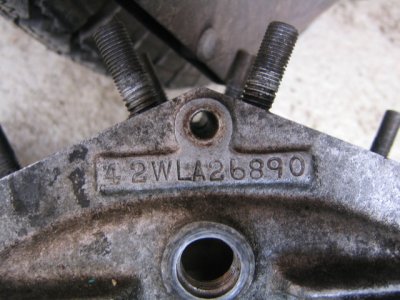
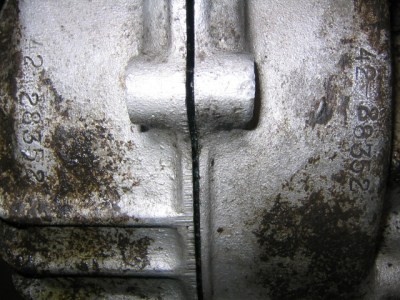
The above images from Norwegian Steffen Hellem illustrate the
correlation between the Engine Serial Number and the Crankcase Production
Numbers. The 42WLA26890 motor came from a Type III 42WLA which came off the line
in late 1942. This is confirmed by the Crankcase Numbers 42-28352.
This was the 28352th motor built by HD in 1942.
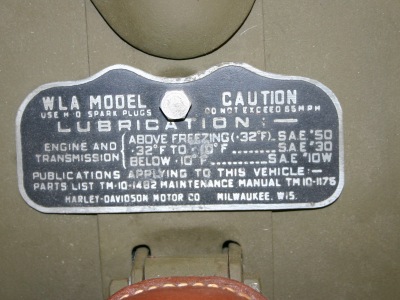

The first pattern Data Plate on a Type III (left) doesn't show
the Engine Number, while the original Data Plate on Yvon Dincau's Type VII
(right) clearly shows Serial Number 42-63442 with a Date of Delivery of October
30th, 1944. Note that 'WLA' is already marked as the model and not marked within
the bike's Serial Number on the plate. The late style Data Plate was first used
on the Type VI 42WLA.
US Army Registration and Markings
All US Army vehicles of WW2 were marked according to Army Regulations (AR) 850-5 to allow the vehicle and unit to be properly identified by Military personnel. The National Symbol of the US Army (5-pointed star) was painted in white on the sides of the vehicles with the US Army registration number and unit identification, stencilled on specific locations, either in Blue-Drab or White paint. On some vehicles the registration number was carried on a license type plate.
For the purpose of registration, all US Army Motorcycles were grouped under 'Class 6' vehicles. This means that the US Army Registration Numbers (USA Number) for all motorcycles began with a '6' followed by a numerical sequence in which the vehicle had been added to the type group. So, a WLA motorcycle had a USA Number in the following style: U.S.A. W-6xxxxx (cf: TM10-1510 The Motor Vehicle, October 1st, 1940, Page 46); the letter 'W' indicating a War Department Vehicle.
Looking at period photographs, one notices a rather large variation in markings depending on the unit, theater of operations and even personal taste of the rider....
US Army
Registration Numbers
A complicated subject for
WLA-owners...
Quote from US Army SNL G-523 Ordnance Supply Catalog, dated September 15th, 1944, page 2:
"The U.S.A. Registration Numbers have appeared on the rear number plates of 1940, 1941, and some 1942 models. On other 1942 models these U.S.A. Registration Numbers are stencilled on the lower portion of the rear mudguard."
This means 42WLAs had the US Army registration number attached below the rear lights on an olive drab 8"x3 3/4" US Army license plate for at least a large part of the production.
In
order to get a clear view on the subject, one needs to look at the different
editions of the Army Regulations describing the Marking of Clothing,
Equipment, Vehicles and Property (AR850-5). The war years 1941 to 1945 saw
three different editions of these regulations (1936-1942-1945).
When the war started the basic regulation describing the marking with US Army
Registration Numbers of Vehicles was the September 25, 1936 edition of AR 850-5.
The number plates displaying the USA Number were described as follows:
"Section III, § 6 d.
Marking. (1)U.S. registration symbols and numbers.
(a) When marked. -- Motor vehicles will be marked with the U.S. registration
symbols and numbers prescribed in AR 850-10.
(b) How marked. -- The marking will be conspicously done on the vehicle with
white paint by means of a stencil and on U.S. registration plates by a metal
stamping device and white painted figures as indicated in (c) below.
(c) Height of letters.-- The height of the letters and figures will be two
inches on trailers, and on U.S. registration plates, and four inches on all
other types of motor vehicles."
Changes No. 2 to the above regulations was issued on April 22, 1942, roughly 5 months before the publishing of the August 1942 edition of the same regulations:
"Section III, § 6 d.
Marking. (1)U.S. registration symbols and numbers.
(a) When marked. -- Motor vehicles will be marked with the U.S. registration
symbols and numbers prescribed in AR 850-10.
(b) How marked. -- The marking on the vehicle will be with blue-drab lusterless
enamel by means of a stencil, and on U.S. registration plates by a metal
stamping device and blue painted figures as indicated in (c) below.
(c) Height of letters.-- The height of the letters and figures will be two
inches on trailers, and on U.S. registration plates, and four inches on all
other types of motor vehicles."
The above Change 2 appears to have been carried forward as far as character and style of marking in AR 850-5, August 5, 1942 shown below. However, in the August 1942 edition, the height was standardised to 2 inches on all vehicles.
Also in the new edition, the moment of applying the marking was described; the original numbers were now to be applied by manufacturers.
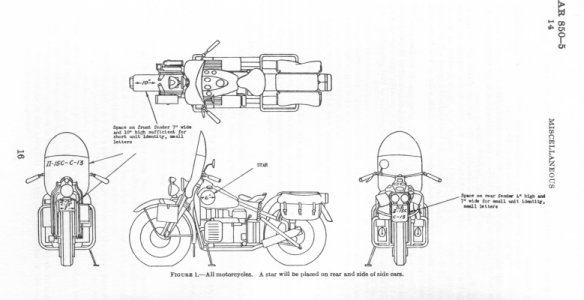
|
|
The August 1942 edition
of AR850-5 above does not specify where the USA
Registration Number should be and there's no mention of a number plate.
The following edition dated February 15th, 1945 states in Section V, §13, b. "the registration markings will be applied with approved white lusterless, stenciling, synthetic enamel". Figure 5 of the same edition shown left clearly shows the USA Number to be painted on the rear fender in front of the luggage rack... Note the position and
size of the stars in both editions. |
Per above Army
Regulations, the
color of the actual numbers on the olive drab plates officially changed from white to blue drab in
April 1942, and the number was to be painted in white again in February 1945.
The
W-prefix found on early plates, was dropped during production of the
Type III. The August 1942 edition of the regulations was published in the middle
of the Type III production and could account for the continued use of the plates
for that entire production run. However Type IVs equipped with a number plate
have also been observed on original WW2 pictures...
Photographs of motorcycles in the ETO show these plates in use well into
1944.
The following conclusions can be made from looking at period photographs:
All motorcycle plates until the end of 42WLA Type II production had white numbers and a W prefix.
During Type III production (somewhere before W-617078) the color of the numbers changed to blue drab (following Change 2 to AR850-5 Dated April 1942, confirmed by the August 1942 edition). Additionally somewhere between W-617078 and 619082 the 'W' prefix was dropped. (Based on an original plate with blue drab U.S.A. 619082 shown in Palmer's book).
Near the end of the Type IV production, numbers were painted in blue drab on the rear fender under the rear lights (NOT on the fender between the battery box and luggage rack). On early Type IV 42WLA where the plate had gone missing, the number was painted in white in a variety of locations and size.
On Type V, VI and VII (throughout the end of WW2 production in August 1945): a blue drab 1” high number was painted directly on the rear fender below the rear lights bracket.
Although the February 1945 edition of AR850-5 prescribed the painting of the number in WHITE between the battery box and luggage rack, this seems to have NOT been done during 42WLA production and was only applied after WW2 for occupation duty and subsequent production.
The above is how 42WLAs left the Milwaukee factory. However the US Army in Europe during WW2 (USAETO) prescribed blue drab vehicle
registration numbers to be repainted in white on all Military vehicles sometime
in 1943 and again in 1944 for the upcoming invasion of mainland Europe; so
plates with blue drab numbers would have been over painted in white, which
explains photos showing plates with white numbers although they would have been
produced in blue drab. Some wartime photos even suggest the numbers may have
been over painted in olive drab.
At the same time numbers seem to have sometimes been painted in white on other
locations on motorcycles (tanks, fenders, etc...)
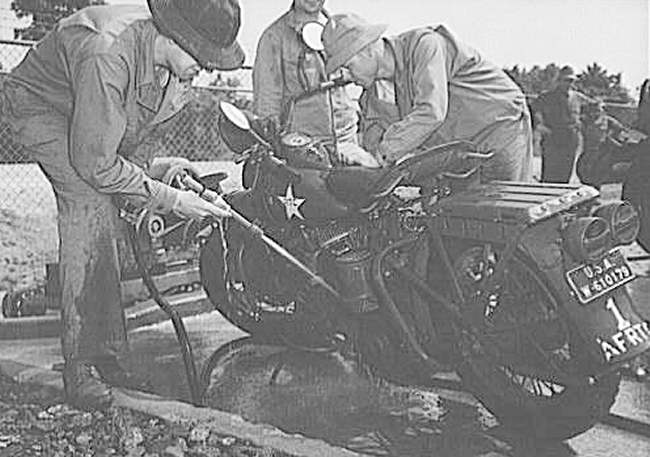
Photo: Phil Suttile
GI's are cleaning dust
and dirt from a Type I 42WLA at Fort Knox in June 1942.
Note the high headlight,
buddy-seat and round air cleaner.
Although the picture's quality is poor, the US Army License Plate with white number U.S.A.
W-610179 is clearly visible.
This early plate is bordered in white and shows the
dash between the 'W' and the numbers.
The marking AFRTC below the huge '1' stands for 'Armored Forces Replacement
Training Center'.
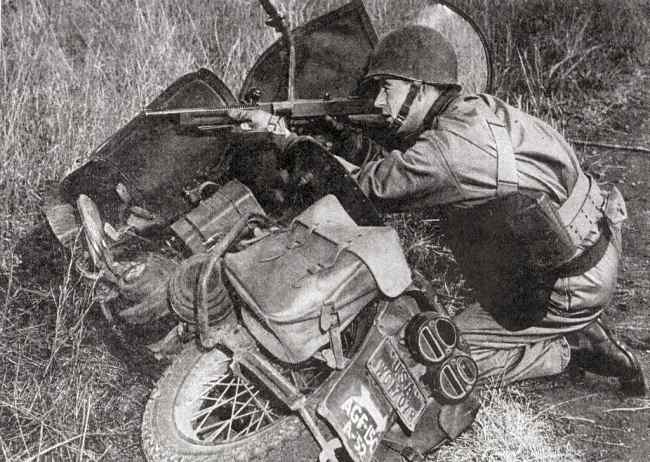
Photo: Sam Cox
A messenger takes aim
behind his Type III 42WLA during manoeuvers, late 1942.
The photo gives a clear view of the US Army License Plate showing a blue drab number U.S.A.
W-617078, the dash barely visible.
The War Department 'W' prefix was dropped at some point during Type III
production.
The painted markings AGF-15C A-52 on the rear fender stand for Army ground
Forces-15th Cavalry Group-Troop A-Vehicle 52
The meaning of the arrow is not clear.
The bike is equipped with a rear wheel driven sirene, a rare item during WW2,
and a pair of brandnew saddle bags.
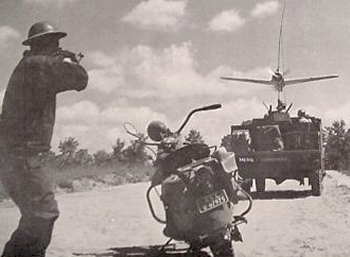
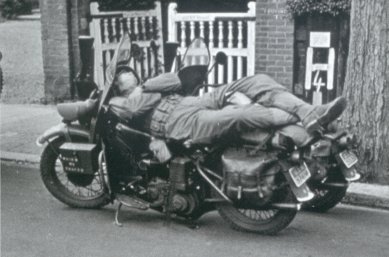
Left: from 'In the Field with the 2nd AD' US Army Publication
1942 & Right: from 'Spearheading D-Day' by J. GAWNE
Left: This 2nd Armored Division's motorcycle carries
number plate USA
W-67975 indicating a 41WLA.
This is confirmed by the handlebars, and combined civilian and military rear
lights.
Right: MP's awaiting embarkation prior to the Normandy invasion in
May 1944.
Note the number plates on which the blue drab number has been over painted in
white per USAETO orders.
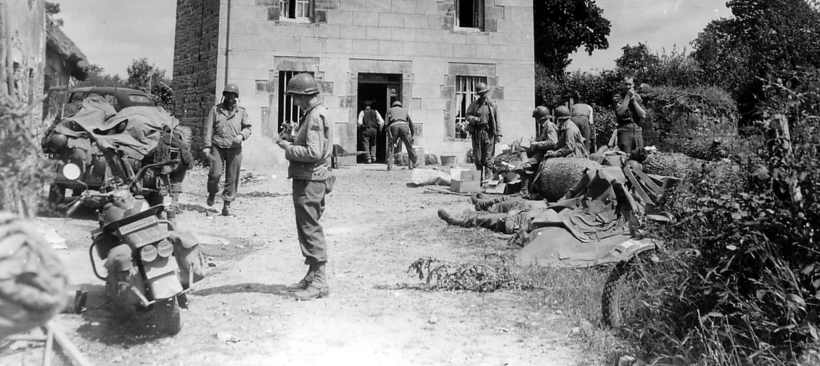
Photo: US Army Signal Corps Photo/National Archives
A Reconnaissance unit from an Armored Unit has taken up
postions in the garden of a French house in the summer of 1944.
Two WLAs are visible in this shot. Of special
interest is the License Plate on the bike on the left and the .30 Cal Ammo Box
attached to the rear fender under the seat.
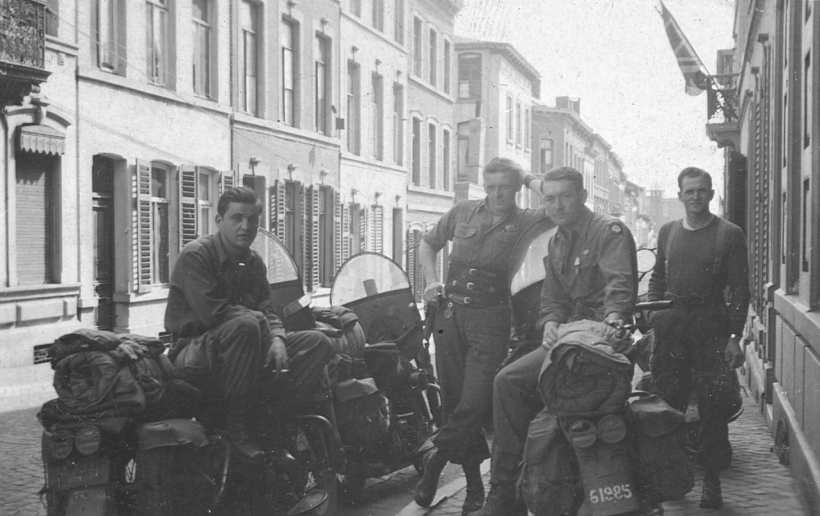
Photo: Tony Tamburino thru
Kenton Falerios
4 MP's from the 82nd Airborne Division with their bikes
in Liege, Belgium in late 1945.
Note the License Plate with blue drab number on the WLA on
the left.
Also of special interest is the number '61985' painted on the rear fender of the
bike on the right. Unless there's one digit missing, it is not a correct US Army
registration number for a 42WLA motorcycle; maybe it's one of those 'Unit
Invasion Codes'??? Who knows?
This picture was published in the excellent
book on the 82nd MP Company, written by Kenton Falerios.
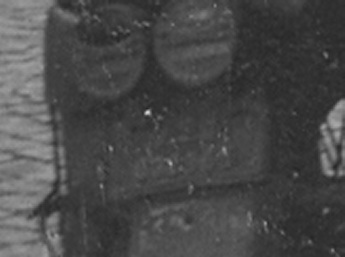
Close-Up from the plate: U.S.A. above a 6-digit number,
exactly like on the original plate shown further below.
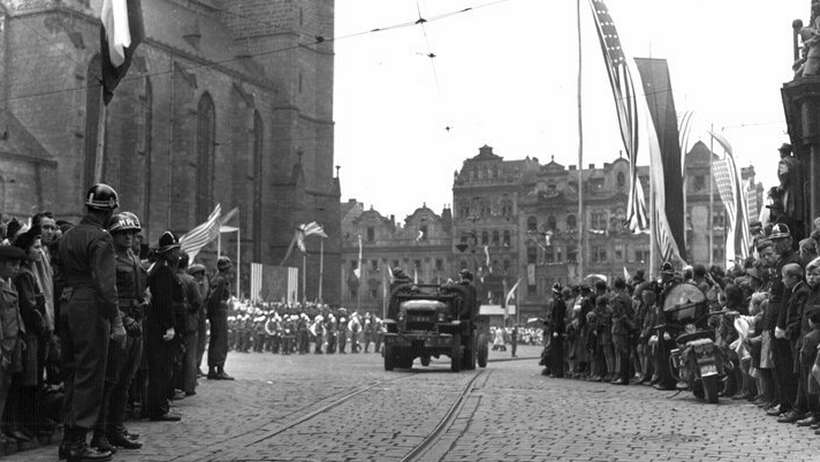
Private Collection
Photo
On 15th June 1945, one
of the largest Victory Parades in Europe was held in Pilsen,
Czechoslovakia.
The picture above was taken during that parade and shows MPs from the 26th
Infantry Division watching vehicles on the Republic Square. The WLA parked on
the right clearly has a US Army Number Plate under the rear lights.
Original and Reproduction US Army License Plates......
Original WW2 Army license plates which were made from a rather flimsy tin metal are rarer than hen's teeth, and good reproductions are hard to get! They are however a very nice detail on any bike.
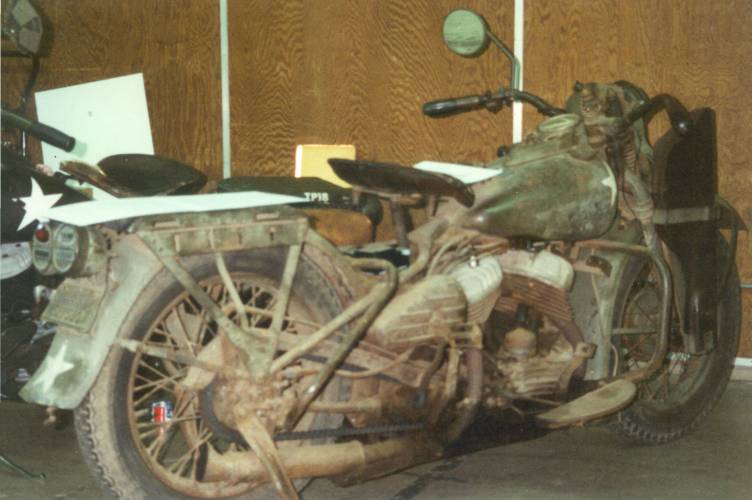
In 1995, Steve Greenberg of Portland, Oregon, discovered this
original unrestored Type III 42WLA. It still had the original US Army License
Plate attached.
This motorcycle was registered as U.S.A. 627580. A close-up of the plate is
shown below!
I photographed the bike at the 1996 MVPA Convention in Portland, Oregon.
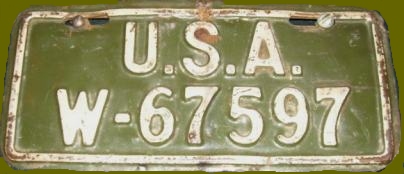 |
Original plate from a 1941 Indian 640B. The numbers are white. Note the 'W' before the registration number and the difference in size and font. (Lex Schmidt Collection) |
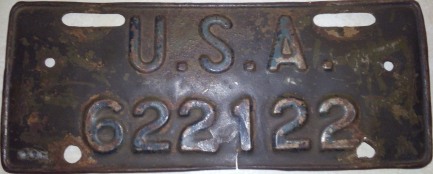 |
Original plate from a Type III 42WLA. The numbers were painted in blue drab. (Brian Goguen Collection) |
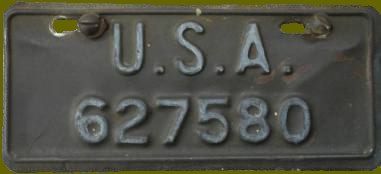 |
Original plate from Steve Greenberg's Type III shown above. The number bears traces of blue drab paint and was most likely over painted in white. |
 |
Reproduction plate. |
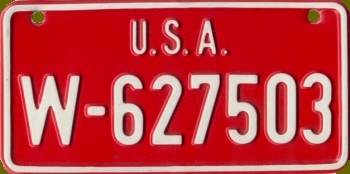 |
Reproduction Plate, sadly made in the wrong color, and with a 'W' for which this number is too high... |
Painted US Army Registration Numbers
As confirmed by SNL G-523 and the different editions of AR850-5 described above, near the end of the Type IV production the USA Registration Number was painted on the rear fender below the rear lights. This was done in standard 1" blue drab letters. No doubt the bikes' fenders were not sufficiently large to use the prescribed 2" stencils.
Photo from an unknown source
A Military Police
WLA in the 'Rue du Chateau' in Cherbourg in the summer of 1944.
Close-up of the bike shows no sign of a License Plate and a blue-drab painted
number is not distinguishable from this distance.
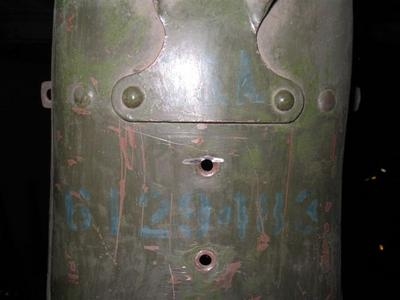
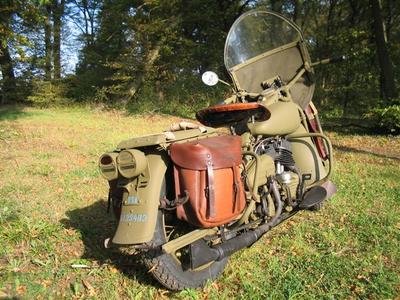
Photos:
Yvon Dincau
Yvon Dincau found the original USA number in 1" blue drab
letters on the rear fender and marked the restored bike accordingly.
USA-6129483
indicates a Type VII and this is confirmed by engine number 42WLA63442.
The February 1945 edition of AR850-5 prescribes the location of the motorcycle's registration number to be on the rear fender between the battery box and the luggage rack. One can only assume the change of location for the painted numbers came too late during WW2 to be applied en masse. However the picture below shows a correctly marked bike in September 1945 in the ETO.
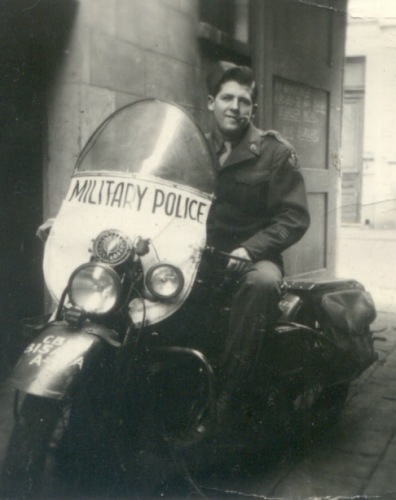
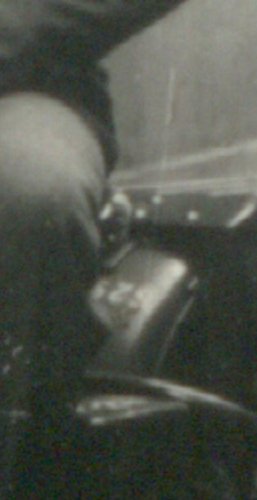
Photo from the Webmaster's Collection
This WLA from the 815th
Anti-Aircraft Artillery Battalion (815th AAA Bn) was photographed in Antwerp,
Belgium, in September 1945. The 815th served as a Military Police unit policing
an area where thousands of GI's passed thru on their way back to the USA!
Note how the USA number is painted in white upside down on the rear fender
between the battery box and the luggage rack, just as prescribed by the 1945
edition of AR 850-5.
On the detail on the right, you can see the 629xxx, the USA remaining invisible
behind the rider's trousers' fabric...
Markings on the front fender are CBS over 815AAA over A-?? which indicates a
motorcycle of A Battery of the 815th AAA Bn attached to the Continental Base
Section. The windshield apron has been painted over in white, with the words
Military Police most likely painted in black.
You can read more about the 815th's MP duty in Antwerp
Here
and Here.
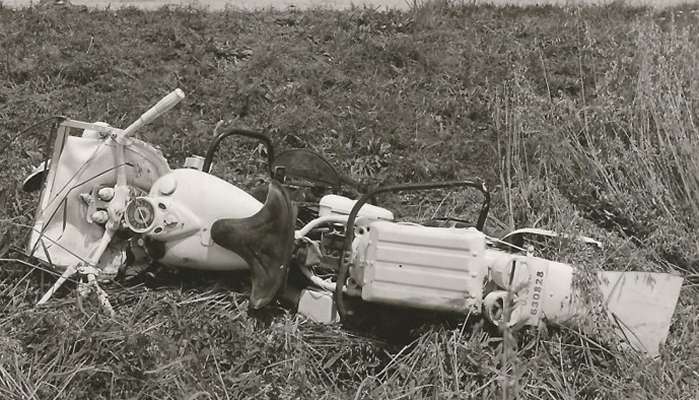
Photo from the Webmaster's Collection
But
even after the end of the war, number plates continued to be used as this photo
taken in Germany in the post-WW2 Occupation period shows.
This white painted US Army Military Police Type III 42WLA was photographed after
being involved in a road accident. The US Army registration number U.S.A. 630828
has been painted in black on a white plate even though at this stage it should
have been stencilled on the rear fender between the battery box and the luggage
rack.
Also note the large mud flap attached to the rear fender.
X-Prefixed US Army Registration Numbers
During the Great War some US Army Officers drove their own vehicles and had them serviced by the Motor Transport Corps. Although these vehicles were private property, due to the fact that they were used in the service, they could benefit from official maintenance and parts. To identify these vehicles they were allotted a US Army Registration Number prefixed by an 'X'.
By the beginning of WW2 the official use of privately owned vehicles had disappeared and the 'X' prefix was carried over to identify vehicles which were not (or no longer) officially listed in Quartermaster or Ordnance files. This was the case for vehicles which were leased from non-US sources (e.g. British made American Red Cross buses,... ), completely rebuilt or adapted vehicles which no longer matched the original model (e.g. Long-wheel-base Jeeps), captured enemy vehicles or vehicles of which the original registration number was not or no longer available or had disappeared.
The
prefix 'X' indicated the registration number was not the vehicle's
original one, but rather a replacement number assigned
to this vehicle by the Ordnance Corps during overhaul or maintenance.
The number issued by the Ordnance Corps would be as follows: U.S.A.
X-61234
The first or first two
digit(s) after the 'X' indicated the Class to which the vehicle belonged (the
motorcycle being Class 6) with the remainder being the number of vehicles of the
same class having been issued a new number.
Looking at the pictures below it seems odd that the WLAs all received X-prefixed numbers in what seems to be the same batch. Seeing other X-prefix numbered vehicles in Britain (Jeeps, Trucks etc...); it becomes clear that the X-prefix numbers were mostly assigned to early vehicles ( Type II WLAs, script Jeeps, etc... ) and therefore one cannot help but wonder if the USA might have shipped multiple numberless vehicles to Britain before they entered the war to have them at their disposal once the troops arrived there. The vehicles could have been shipped in the Lend-Lease program and since they carried no USA numbers wouldn't have been considered US Army vehicles... But of course this is only speculation...
|
|
'Darby's Rangers' Lt Col Darby, CO of
the 1st Ranger Battalion, in front of the City Hall of Arzew, Algeria on
November 16th, 1942...
The number 'USA X-61447' is painted on the oil tank. Also of interest here is the M1938 Leather Rifle Scabbard carried in the provided bracket on the front forks. The rifle is a M1903 Springfield Model. The Officer talking
to Darby has a British Made F-S Commando knife attached to his pistol
belt teween the .45 pistol and the first aid pouch. The dagger is no
doubt a souvenir from training with the Commandos in Achnacarry,
Scotland. |
'Friendly
Invasion'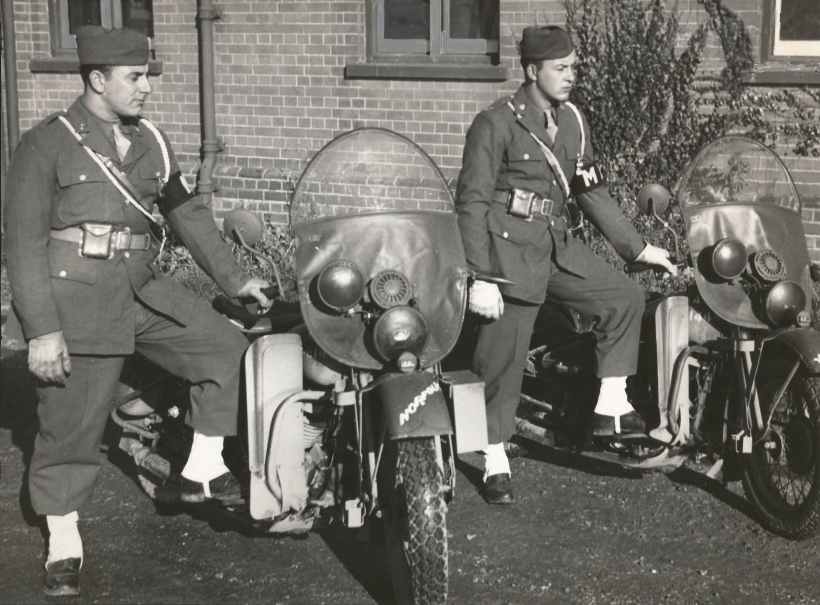 Photo from the Webmaster's Collection |
|
Two American Military Policemen stand next to their motorcycles somewhere in England in November 1942. The
bikes are Type II 42WLA without Black Out Driving light but both fitted
with large pursuit lights. The MPs are wearing the standard Wool Uniform with MP brassard and white
leggins. |
|
'Rum-Dum' A Sergeant poses on a WLA somewhere in England in 1944.
The bike is clearly a
Type II 42WLA with a Bicycle Pedal style kick starter and high mounted
Horn. This particular WLA would have been delivered with a US Army number plate mounted underneath the rear lights. However other pictures from the same bike show the plate is missing and therefore a US Army registration number has been applied to the side of the oil tank. The applied number USA 61909 is most likely another X-prefixed number with the X missing from the tank as USA 61909 was not an officially attributed 42WLA number during the war. The
Technician 4th Grade (T-4) is wearing the standard US Army Wool Uniform
of the era. He is armed with a .45Cal M1911A1 Pistol. The caption on the
original picture mentions his first name 'John', nicknamed 'Doc'. |
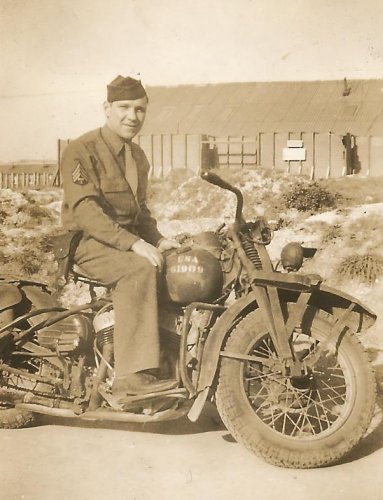 Photo from the Webmaster's Collection |
The Radio Suppression S Marking
The only other factory-applied marking is the blue-drab letter 'S' on vehicles
equipped with a Radio Interference Suppression System.
On WLA motorcycles this system consisted of a braided ground strap on the coil
and later also on the front cylinder head and condensers.
The 2"
high 'S' marking was applied on both sides of the dash cover from Type III 42WLA
with U.S.A. 624964
registration number
onwards. The 'S' was to be applied in the same color and size as the Army
Registration number which was blue-drab until the February 1945 regulations
changed it to white again...
Although the 'S' was already being applied to US Army vehicles as early as 1942,
the first time the marking appears in regulations is in Changes No. 9 to AR850-5
Dated January 27th, 1944
"Section III, § 12 f. Letter "S"
(1)The letter "S" will be used on a military vehicle to indicate that a vehicle so marked has been suppressed to eliminate radio interference, caused by the vehicle electrical system, over a frequency range 0.5 to 30 megacycles.
(2) The letter "S" symbol will be placed after the registration number and will be made as conspicious as possible by leaving a space between the last numeral and the "S". This space should be equivalent to the space required for a numeral. Design, size and color of the letter will be the same as that of the digits of the registration number. The character and style of markings of a vehicle suppressed to eliminate radio interference will be as follows:
U. S. A.
123726 S
(3) The letter "S" will be applied originally to a vehicle either by the vehicle manfacturer at the time of assembly or by the authorized persons effecting suppression in the field. If a suppressed vehicle is repainted, the letter "S" will be reapplied in the manner and location described in (2) above.
On the WLA the 'S' was painted on both sides of the dash cover until regulations stipulated the 'S' was to be added to the US Army Registration Number. Very late during WLA production it was stencilled as prescribed after the motorcycle's U.S.A. registration number on the rear fender below the rear lights.
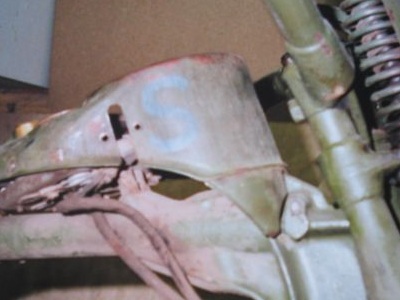
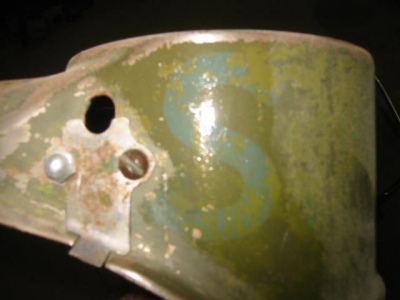
Upon manufacture, a 2" blue drab 'S' was painted on each
side of the instrument panel to indicate the motorcycle was originally equipped
by HD with a Radio Interference Suppression System.
Above are two examples of original markings with a restored marking shown below.
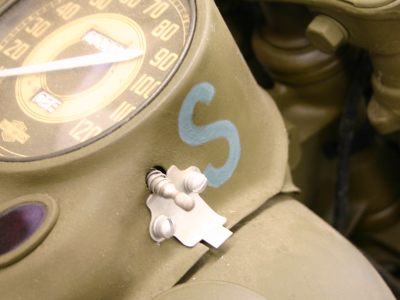
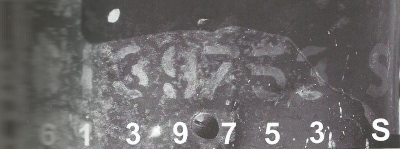
Photo from Bruce Palmer's
'How to restore your Military Harley-Davidson' Second Edition
Somewhere between USA-6129483
and USA-6139753 the S was no longer painted on the sides of the dash cover
but as prescribed following the registration number on the rear fender under the
rear lights, leaving a one digit space between the number and the 'S'.
Note the style and font of the 1" inch original marking from the Bruce Palmer
collection.
Unit Markings & Stars
Other markings were applied in the motorcycle's unit motorpool (Stars, Unit Codes, Military Police markings etc...) and varied greatly from one unit to another. Although prescribed in the same Army Regulations, Theater or Unit Commanders could order special markings to be applied to the vehicles of the units under their command. Also specific tactical markings were sometimes applied in view of an upcoming operation.
Click Here for an excerpt from the 1942 edition AR 850-5 about Unit Identification Markings.
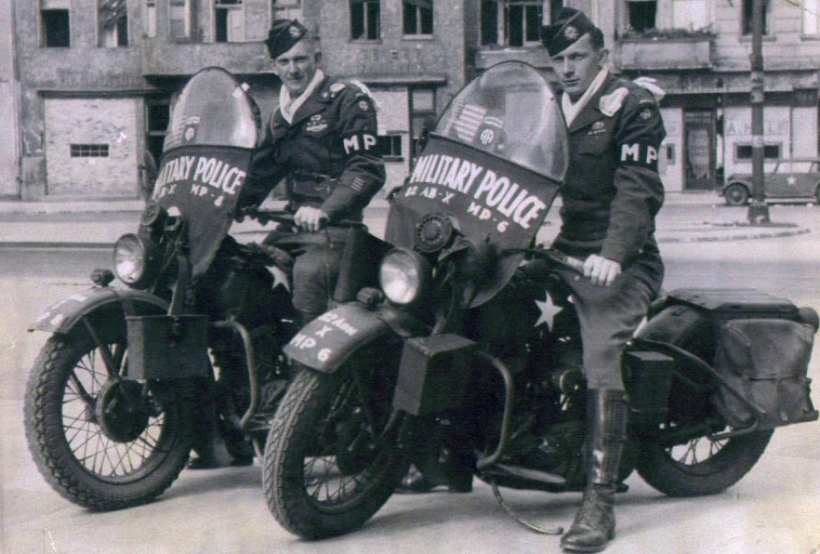
Photo: Chad Conway
thru Kenton Falerios
Cpls Conway and Doubfit
of the 82nd Airborne Division' MP Platoon patrol Berlin in May 1945.
Their bikes are marked as precribed by 1942 AR 850-5, with the National
Symbol (star) on the tanks and the unit identity on both the front fender and
windshield apron. The US Army Registration is probably painted on the rear
fender below the rear lights.
This picture was published in the excellent
book on the 82nd MP Company, written by Kenton Falerios.
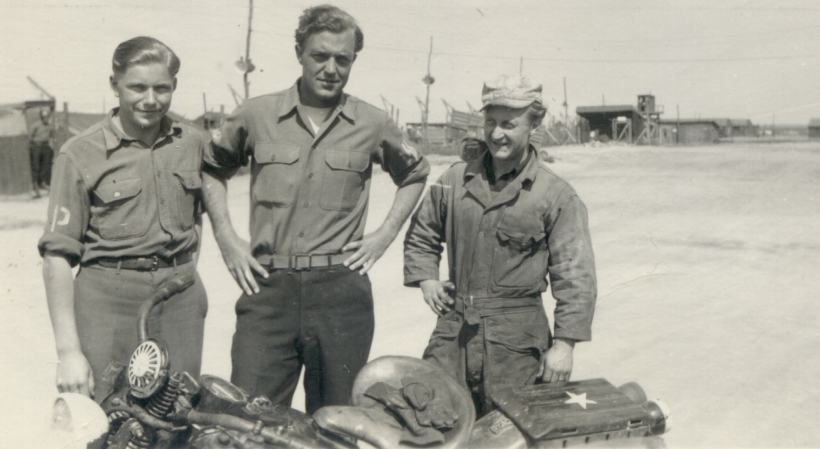
Photo
from the Webmaster's Collection
Two German POWs,
wearing US Wool shirts marked accordingly, stand next to a WLA with its GI rider
at the US Army POW Camp at Laon, France in 1945.
A white star has been painted on top of the luggage rack and parts of the
headlight and horn have been painted white.
Period photographs show that despite of clear regulations, markings were applied
in many different ways.....
Shipping Markings
Many US Army vehicles were shipped to the theaters of operation in crates where they were uncrated, assembled and issued to the combat units. Some of the vehicles however were shipped fully assembled. In order to use the available shipping space to the fullest, sometimes vehicles were marked with 'Shipping Markings' detailing their dimensions. Initially these markings were applied with paint, but from the spring of 1944 onwards some vehicles were produced with a permanently attached shipping data plate. No plate was made for the WLA and shipping markings were rarely applied to motorcycles, but there are a few examples showing up on period photographs. Shipping details observed describing length, width, height and weight for the Model 42WLA are:
|
OL 7'5 |
Preparation for Overseas Movement (POM) Markings
In the build-up to
large-scale military operations during WW2, the US Army introduced a system by
which all items that were to accompany a unit on an overseas voyage could be
correctly identified to their respective units. These items included large
personal equipment to vehicles and tentage.
By assigning each unit a
5-digit serial number, all items could be easily identified. To expedite this
identifying process in the system, a color code was also
devised, with specific colors relating to the final two digits of the 5-digit
code. These particular markings, referred to as "Preparation for Overseas
Movement" (POM) markings were designed to replace unit idenfication markings,
thus making organisation and transportation simple.
Each unit, down to Company
level, was issued with a 5-digit code which uniquely identified it. Each number
of the code corresponded to a color, which would be painted in the form of
three stripes, representing the following: top and bottom bar: penultimate digit,
middle bar: final digit. Sometimes the bars were painted on a white square,
especially if olive drab bars were used.
The table below shows the digits used and their corresponding colours:
| 0 | 1 | ||
| 2 | 3 | ||
| 4 | 5 | ||
| 6 | 7 | ||
| 8 | 9 |
Below are two
examples of original POM markings
Left: a CS-79 Battery Box for an SCR-609/610 Radio Set with number 45164 which was attributed to the 293rd Joint Assault Signal Company which
landed with the first wave on Omaha Beach during the Normandy invasion on 6th
June 1944.
Right: a Duffelbag with number 46531 which was Headquarters Detachment, Advance
Section, Communications Zone.
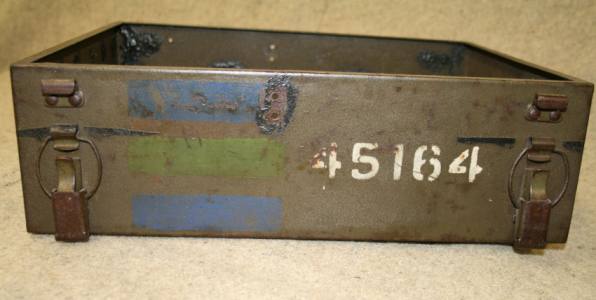
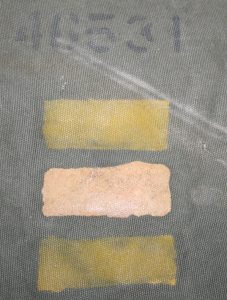
Items from the Webmaster's
Collection
To learn more about POM marking, please click Here!
The picture below illustrates both Shipping and POM Markings
|
|
'French Summer of '44.....' This fantastic image shows Pvt Robert J Vance, from Portland, Oregon, riding his bike as a messenger of the 33rd Armored Regiment of the 3rd Armored Division in the fields of Normandy in late July, 1944. He wears wool trousers and
shirt and headgear consists of the Tanker’s helmet. A 3rd AD decal is
applied to the front of the helmet. Goggles are the M1943 type. His
Lightweight Gas Mask Bag and M3 Binoculars in their M17 Leather Case are
attached to the front forks and handlebars. An M1 Carbine is carried in
the leather scabbard. Ammo pouches for the carbine are visible on the
carbine stock and on the M1936 Pistol Belt. A (British?) shovel is carried
between the leather straps of the rear saddle bag…. |
Tire Pressure Markings
During WW2 the tire pressure was not a prescribed marking for US Army vehicles and when it was applied, it was usually in a location in plain view of the vehicle's operator. For a motorcycle this would have been on the inside of the windshield or on the tank. The TP marking on the fenders above the wheels is a post-WW2 marking.
Standard WLA/WLC Tires in WW2
WLA/WLC Motorcycles came off the assembly line
fitted with 'Firestone Sportsman' Type 4.00-18 tires, recognisable by the
distinctive cross-lug pattern tread. But other tires have been observed on these
bikes, as mechanics would have fitted whatever was available during maintenance
or overhaul. Thus far five different types of tires have been observed on
wartime pictures of WLA Motorcycles, and they are all illustrated on the ads
from 1939 below...
These original tires are made of very hard
rubber and are not safe to ride!
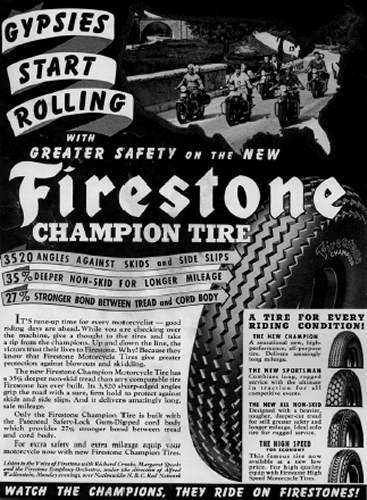
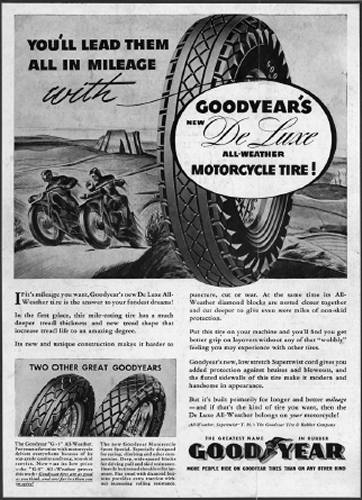
Ads: Martin Bogaert Collection
Tires mounted on the WLA
include the 'Sportsman' and 'All Non Skid' (ANS) type from Firestone and Good
Year's 'G3' 'All Weather' and 'Motorcycle Sport Special'. Note that the
Firestone 'High Speed' type is sometimes mounted on motorcycles and is generally
found on original USMC Ammunition Hand Carts, while the Firestone 'Champion'
type has been seen on Indian motorcycles and on one French 'Lend-Lease' WLA.
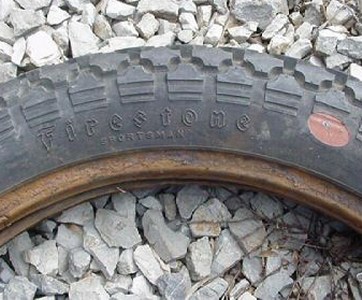
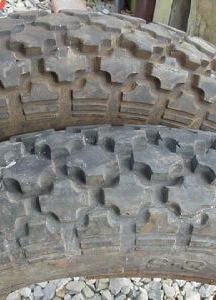
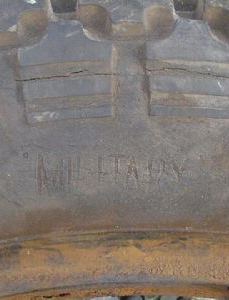
Tires from a Private Collection
A clear view of the
Firestone Sportsman tires and their distinctive tread pattern
The markings 'MILITARY' indicate its obvious use while the red dot and
'S-3' indicating synthetic 'war-production'
rubber.
How to recognise the different types.....
On original WW2 images, it's impossible to make out the engine number and only typical features of each type can help in properly distinguishing a certain type of 42WLA from another. Again using Bruce Palmer's books, I've compiled the list below to aid in identification and this chart should enable any WLA buff to distinguish different types....
| Type 42WLA | Rapid Identification Distinguishing Features |
| Type I | High Ammo Box, First Pattern Front Fender, Round Air Filter, High Headlight, No BO Driving Light, Natural Finish Crankcase, Transmission and Cylinder Heads, Bicycle Type Starter Pedal, Silver Painted Carburetor Body, Aluminum Carburetor Air Inlet Connector, Early Style Data Plate, H-700 Keyed Ignition, Leatherette Windshield Apron |
| Type II | High Ammo Box, First pattern Front Fender, Round Air Filter, Low Headlight, No BO Driving Light, Natural Finish Crankcase, Transmission and Cylinder Heads, Bicycle Type Starter Pedal, Silver Painted Carburetor Body, Aluminum Carburetor Air Inlet Connector, Early Style Data Plate, H-700 Keyed Ignition, Leatherette Windshield Apron |
| Type III | High Ammo Box, First Pattern Front Fender, Rectangular Air Filter, Low Headlight, BO Driving Light (from approx 42WLA20395), Natural Finish Crankcase, Transmission and Cylinder Heads, Bicycle Type Starter Pedal replaced by Steel Spool Type Starter Pedal (somewhere around mid-Type III production), Silver Painted Carburetor Body, Aluminum Carburetor Air Inlet Connector, Early Style Data Plate, H-700 Keyed Ignition, Leatherette Windshield Apron |
| Type IV | Low Ammo Box, First Pattern Front Fender, Rectangular Air Filter, Low Headlight, BO Driving Light, OD Painted Crankcase and Transmission and Black Painted Cylinder Heads, Steel Spool Type Starter Pedal, Silver Painted Carburetor Body, Aluminum Carburetor Air Inlet Connector, Early Style Data Plate, H-700 Keyed Ignition, Leatherette Windshield Apron (Canvas from June 1943 at approx 42WLA42000) |
| Type V | Low Ammo Box, First Pattern Front Fender (up to approx 42WLA53000), Second Pattern Front Fender (at approx 42WLA53000), Rectangular Air Filter, Low Headlight, BO Driving Light, OD Painted Crankcase and Transmission and Black Painted Cylinder Heads, Steel Spool Type Starter Pedal, OD Painted Carburetor Body, Steel Carburetor Air Inlet Connector, Early Style Data Plate, Keyless Ignition, Embossed OIL Label on oil tank, Canvas Windshield Apron |
| Type VI | Low Ammo Box, Second Pattern Front Fender, Rectangular Air Filter, Low Headlight, BO Driving Light, OD Painted Crankcase and Transmission and Black Painted Cylinder Heads, Steel Spool Type Starter Pedal, OD Painted Carburetor Body, Steel Carburetor Air Inlet Connector, Late Style Data Plate, Keyless Ignition, Embossed OIL Label on oil tank, Canvas Windshield Apron |
| Type VII | Low Ammo Box, Second Pattern Front Fender, Rectangular Air Filter, Low Headlight, BO Driving Light, OD Painted Crankcase and Transmission and Black Painted Cylinder Heads, Steel Spool Type Starter Pedal, OD Painted Carburetor Body, Steel Carburetor Air Inlet Connector, Late Style Data Plate, Keyless Ignition, Deep Water Crankcase Relief Pipe, Transmission Breather Pipe, Embossed OIL Label on oil tank, Canvas Windshield Apron |
With the
above table, it shouldn't be too hard to take a short test.....
What types 42WLA are
illustrated below????
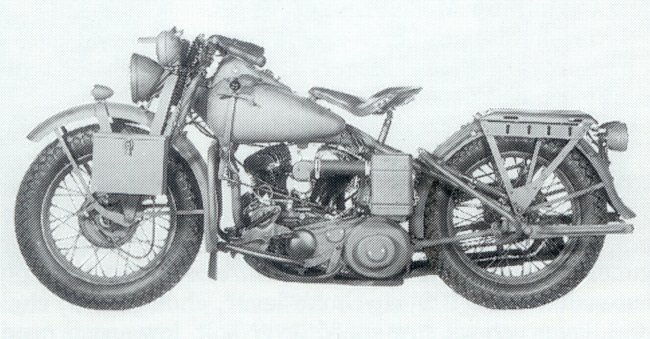
Images from Bruce Palmer's 'How to restore your military HD'

You will find the correct answers by clicking HERE......
Of course once
motorcycles were in service and in need of maintenance or overhaul, parts of
different types were mixed as the US Army Ordnance Dept didn't care to keep the
bikes in as issued condition.
That is why sometimes you see early bikes with later features or later
production models with early parts.
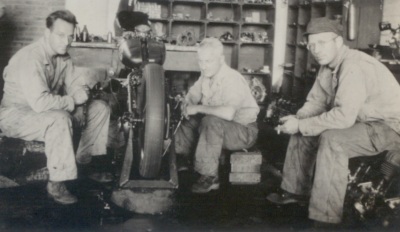
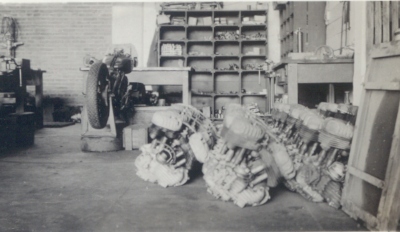
Photos from the Webmaster's Collection
Three US Army
mechanics do a test run on a WLA engine in their workshop in Leghorn (Livorno),
Italy late in WW2.
The picture on the right shows many engines awaiting installation and testing.
Upon reassembly mechanics would use whatever parts available to put a bike back
together, without much thought about how the bike left the factory...
Note the US Army star marking barely visible on the side of the tanks.
'US Navy and US Marine Corps WLAs'
By 1943 the War
Department and the Navy Department were working together and formed the 'Joint
Army-Navy Standardization Committee for Vehicles and Construction Equipment'. As
a result of this committee, the US Navy used Army specifications for their
automotive equipment. One type of standard vehicle obtained by the US Navy from
the US Army was
the Harley-Davidson 42WLA Motorcycle (another being the famous Jeep...). Several
thousands of WLAs were acquired by the Navy Department and most were delivered
to the USMC. These bikes were all issued in their standard Army livery, but
sometimes hastily painted Navy gray.
These bikes, like other Navy Department vehicles, were most likely assigned a US Navy Number.
Only the Big Twins acquired by the Navy and Marine Corps under Navy specifications, were delivered in Navy Gray or Marine Corps Green, since the Army no longer ordered these heavier bikes....
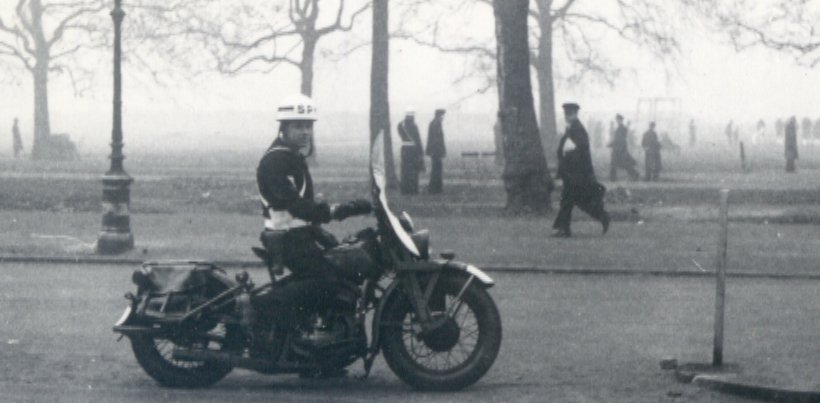
Photo from the Webmaster's Collection
A US Navy Shore
Patrol (SP) member on a WLA in a foggy English park during WW2.
The bike looks like a standard Army WLA, with fenders, apron and horn
highlighted in white.
It is not clear whether the bike belongs to the US Navy or is borrowed from a
local Army Military Police Unit.
Note the Fire extinguisher bracket on top of the rear crash bars and the
missing 'fin' on the muffler.
'Lend-Lease' WLAs
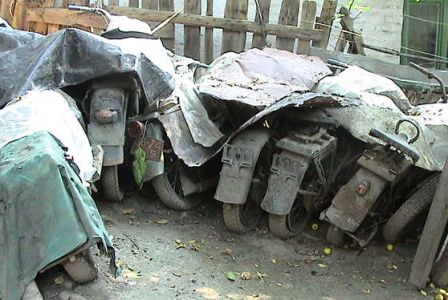
Private photo via Martin
Bogaert
Look at the image above? Is this a US Army Depot somewhere in Europe at the end of WW2?
No, actually the picture was taken in the early 90's in Russia. There are thousands of bikes still around in Russia, some well restored, other complete wrecks.... During WW2, about half of the total WLA production was shipped to other countries under President Roosevelt's 'Lend-Lease' program, which explains why there seem to be so much more 'Liberators' in countries other then the US.
To read more
about these 'Lend-Lease' WLAs, please click
HERE!
'WLAs fitted with Side-Cars'
Contrary to
what many restorers believe, US Army WLAs were never fitted with side cars
during WW2.
The WLA frame and engine were considered too light and the US Army always
classed their 45ci bikes as 'Solo'. The motorcycles they did order with sidecars
from Harley-Davidson were all Big Twin 74ci models.
However some countries who received WLAs under the 'Lend-Lease'
act did attach sidecars to the bikes.
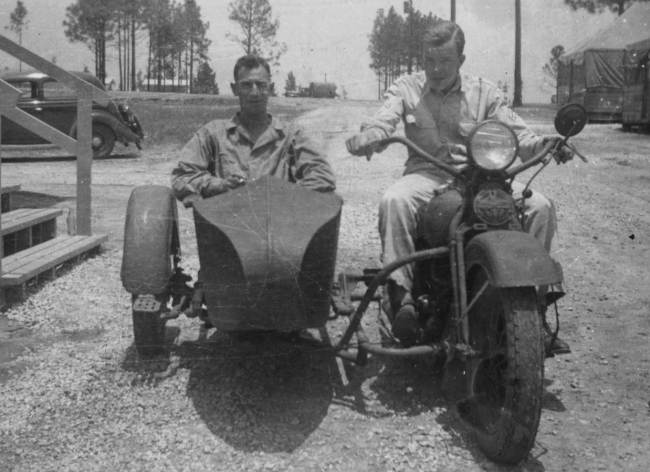
Photo: Kurt Riffe from '45
Parts Depot'
Pvt Patton and Cpl
Grover Pace from the US Army's 32nd Infantry Division pose on a Harley-Davidson
equipped with a sidecar in 1941.
While the bike could easily be mistaken for a 45ci WLA, actually it is a 74ci
Big Twin Model 39UA fitted with an LE sidecar.
Most if not all of the 39 Models were supplied to National Guard units; the 32nd
Inf Div being the Wisconsin and Michigan NG.
'WLCs: Canadian Liberators!'
Although not
the main scope of this site, the WLC Motorcycle needs to be included on these
pages....
The WLC Model differs in many details from
its American counterpart. It was mainly used by the Canadian (and Commonwealth)
Armies, although a few were also used by the US Army during WW2.
Typical 43WLC
'Export' Model
How many differences with the WLA Model can you spot?......
Click on the image above if you want to go straight to the Model WLC Pages.....